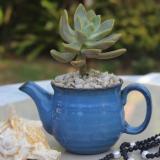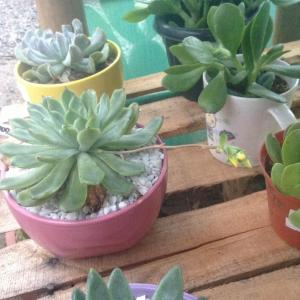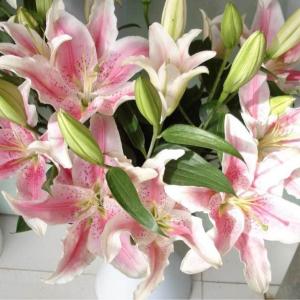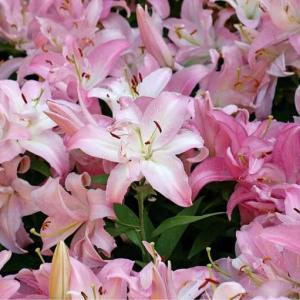文章
Joss
2017年02月20日

#Blue flowers are some of the most striking plants around and can add a rich splash of color to any garden. Plant them in a cluster of all blue or mix them in with other flowers for a rainbow of color.
When planting flowers, it is important to remember to follow the instructions on the tag for the plant. Always buy plants that will thrive in the conditions in which you intend to grow them. A plant that loves sun will not do well in a shady area and you will only be disappointed with the results.
When planning your garden, be aware of the bloom time of the flowers. Planting perennials with different bloom times near each other will insure a garden that has blooms all season long. Remember also to plan for the height of the plants, putting the taller ones in the back.

Consider the flowers on the list below for your garden.
Polemonuim aka Blue Pearl – A compact plant with deep sky blue flowers that grows to 10″. It blooms in late spring to early summer. Plant in partial shade and in well drained soil.
Blue Sea Holly – This dramatic plant has a lavender blue cone like flower with long spiked petals. It grows to 30″ and is a favorite for dried flower arrangements. Plant in full sun – blooms in mid to late summer.
#Delphinium aka Butterfly Blue – Bright blue delicate flowers adorn a plant that blooms in early to mid summer. It reaches 10″ tall and prefers a sunny location with rich moist soil.
#Campanula aka Blue Carpet – Bright blue to lilac colored flowers bloom for weeks in the middle of summer. This low growing perennial grows to 4″ and prefers full sun with well-drained soil.
#Penstemon aka Blue Buckle – This plant has tubular shaped blooms in blue to purple and flowers in mid summer to early fall. It grows to 15″ and likes well-drained soil with full or partial sun.

#Hydrangea aka Nikko Blue – Gigantic clumps of blue flowers adorn this shrub for most of the summer. In the fall, the flowers turn a golden color. This plant is a new variety that prefers rich soil but will grow in shade, partial sun, or full sun.
#Vinca – Medium blue flowers and glossy green leaves form a carpet that grows to about 6″ tall and blooms in mid spring. This plant will grow in most soil conditions, in the shade or sun.
#Ajuga aka Bronze Beauty – This short bushy plant has spikes of blue flowers that grows quickly. Great as a ground cover or in raised beds. It blooms in spring and prefers a shady area.
#Scabiosa aka Butterfly Blue – A bushy perennial with lavender blue flowers that bloom from June to October. This plant likes full sun and attracts butterflies and hummingbirds.
Verbena aka Babylon Blue – Blue purple flowers petals adorn a plant that blooms in early spring. Great for window boxes and planters.
When planting flowers, it is important to remember to follow the instructions on the tag for the plant. Always buy plants that will thrive in the conditions in which you intend to grow them. A plant that loves sun will not do well in a shady area and you will only be disappointed with the results.
When planning your garden, be aware of the bloom time of the flowers. Planting perennials with different bloom times near each other will insure a garden that has blooms all season long. Remember also to plan for the height of the plants, putting the taller ones in the back.

Consider the flowers on the list below for your garden.
Polemonuim aka Blue Pearl – A compact plant with deep sky blue flowers that grows to 10″. It blooms in late spring to early summer. Plant in partial shade and in well drained soil.
Blue Sea Holly – This dramatic plant has a lavender blue cone like flower with long spiked petals. It grows to 30″ and is a favorite for dried flower arrangements. Plant in full sun – blooms in mid to late summer.
#Delphinium aka Butterfly Blue – Bright blue delicate flowers adorn a plant that blooms in early to mid summer. It reaches 10″ tall and prefers a sunny location with rich moist soil.
#Campanula aka Blue Carpet – Bright blue to lilac colored flowers bloom for weeks in the middle of summer. This low growing perennial grows to 4″ and prefers full sun with well-drained soil.
#Penstemon aka Blue Buckle – This plant has tubular shaped blooms in blue to purple and flowers in mid summer to early fall. It grows to 15″ and likes well-drained soil with full or partial sun.

#Hydrangea aka Nikko Blue – Gigantic clumps of blue flowers adorn this shrub for most of the summer. In the fall, the flowers turn a golden color. This plant is a new variety that prefers rich soil but will grow in shade, partial sun, or full sun.
#Vinca – Medium blue flowers and glossy green leaves form a carpet that grows to about 6″ tall and blooms in mid spring. This plant will grow in most soil conditions, in the shade or sun.
#Ajuga aka Bronze Beauty – This short bushy plant has spikes of blue flowers that grows quickly. Great as a ground cover or in raised beds. It blooms in spring and prefers a shady area.
#Scabiosa aka Butterfly Blue – A bushy perennial with lavender blue flowers that bloom from June to October. This plant likes full sun and attracts butterflies and hummingbirds.
Verbena aka Babylon Blue – Blue purple flowers petals adorn a plant that blooms in early spring. Great for window boxes and planters.
1
0
文章
Joss
2017年02月18日


Mums, or #Chrysanthemums , are one of the most popular and classic fall flowers for the garden of all time. With good reason! They come in a wide array of colors, last well into frost, and keep a dying landscape looking fresh and colorful while we ready ourselves for letting go of the growing season. But there are some tricks to growing them, and some of them may catch you off guard. Here are the five mistakes most people make growing Mums, and how to correct them!
Mistake 1
Planting Mums from the gift section.
If your Mums come in a foil wrapped pot, I have news for you. It’s gonna die. Chances are a well meaning friend gave you this plant in late fall as a gift, and intended for you to plant it in your garden for next year. The problem with that is that gift plants are grown entirely in a greenhouse. Which means, they have never been conditioned to living outdoors. Add to that the fact that nights are growing cold, and frost is just around the corner, and there is no way these plants can harden off before winter sets in. Just enjoy them on a sunny window sill. Then let them go. :) Then look for nursery grown plants called “hardy” Mums. And get them in the ground no later than early fall. (And spring is better!).
Mistake 2
Forgetting to Feed! Mums are heavy feeders, and they are even more voracious if they are planted in containers. Feed, feed, feed!
Mistake 3
Expecting them to be hardy while planted in containers. While I do use Chrysanthemums in containers, and I have had them overwinter and come back in the spring, this is the exception. When plants are in containers, there root systems are less protected. If you plant Mums in containers, treat them as annuals and plan to replace them next year. This is why they are cheap!

Mistake #4-
Not Pinching! When Mums are about six inches tall, and then again at twelve inches, you should pinch off the tips of the branches. This forces the plant to grow more compact, and thus avoids that awkward “floppy” stage right before they are ready to open their blooms, ruining the whole seasons growth!
Mistake 5
Not taking advantage of Mums in the garden bed. You know what, don’t wait for fall to think “I want some Mums to add fall color!”. Plant Mums in the spring with your other perennials, and make sure you try varieties of different size, colors and flowers shape. Think of Mums kind of like planting bulbs in the fall… you know you won’t see those tulips bloom until the next season, but it’s worth the wait.
2
0
文章
Andrea
2017年02月17日

If you want a great #vegetable #garden you need to use raised garden beds. Raised beds are great for growing healthy, productive vegetables and flowers and they’re easy to make.
Making a raised bed is a simple bit of carpentry that anyone should be able to do. The easiest way to buy some 2×12 lumber and screw them together in the shape of a rectangle. You can make them as long as you like but you should limit the width to 3 or 4 feet so you can easily reach in the bed to plant seeds, pull weeds or to harvest crops.
The next question you’re probably asking is what kind of wood do I use to build raised beds. The whole pressure treated vs. non issue is a complicated one. Does pressure treated wood leach chemicals into the soil? Well the answers are yes and maybe.

The old pressure treated lumber (CCA) is preserved with a process that uses arsenic. Obviously you don’t want arsenic anywhere near something you’re going to eat even in the small amounts that might be present in a raised bed vegetable garden. CCA wood isn’t too readily available anymore so you probably don’t have to worry about coming across it. The new improved pressure treated wood (ACQ) replace CCA pressure treated wood a few years ago. The lumber industry says it safer to handle and use but guess what? It eats through normal galvanized screws and fasteners. You have to use stainless steel screws with ACQ wood. I’m not an expert with lumber or chemicals but that sounds like something that shouldn’t be near my vegetables.
I think I’ll avoid all pressure treated wood until some long term studies are done.
Naturally rot resistant woods like cedar and redwood are great for building raised beds. But cedar and redwood are expensive. You could also use regular non-pressure treated lumber but just be aware that the wood will probably rot in a few years. It’s inexpensive enough that it shouldn’t be an issue.
If you plan on growing vegetables or flowers in your yard this year, why not try growing them in raised garden beds.
Making a raised bed is a simple bit of carpentry that anyone should be able to do. The easiest way to buy some 2×12 lumber and screw them together in the shape of a rectangle. You can make them as long as you like but you should limit the width to 3 or 4 feet so you can easily reach in the bed to plant seeds, pull weeds or to harvest crops.
The next question you’re probably asking is what kind of wood do I use to build raised beds. The whole pressure treated vs. non issue is a complicated one. Does pressure treated wood leach chemicals into the soil? Well the answers are yes and maybe.

The old pressure treated lumber (CCA) is preserved with a process that uses arsenic. Obviously you don’t want arsenic anywhere near something you’re going to eat even in the small amounts that might be present in a raised bed vegetable garden. CCA wood isn’t too readily available anymore so you probably don’t have to worry about coming across it. The new improved pressure treated wood (ACQ) replace CCA pressure treated wood a few years ago. The lumber industry says it safer to handle and use but guess what? It eats through normal galvanized screws and fasteners. You have to use stainless steel screws with ACQ wood. I’m not an expert with lumber or chemicals but that sounds like something that shouldn’t be near my vegetables.
I think I’ll avoid all pressure treated wood until some long term studies are done.
Naturally rot resistant woods like cedar and redwood are great for building raised beds. But cedar and redwood are expensive. You could also use regular non-pressure treated lumber but just be aware that the wood will probably rot in a few years. It’s inexpensive enough that it shouldn’t be an issue.
If you plan on growing vegetables or flowers in your yard this year, why not try growing them in raised garden beds.
0
0
求助
Donnajo C Stoops
2017年01月18日

this is my grandmothers orchid shes had it for a few years were going to repot soon but dont now alot about them anyhelp will do...we have noticed that the stem is dry an lookd dead it reblooms but is this normaly an when should the flowers re bloom?
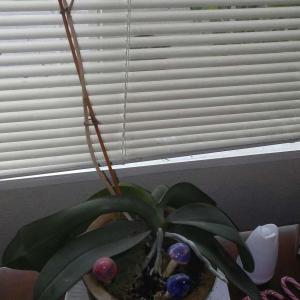

0
0
Donnajo C Stoops:thank u andy ill be filling my grandmother in on this article as well as learning the caring process
Andy:You can find it in Discover->latest article->how to care for Phalenopsis
Andy:Maybe this article can help your flower re bloom.
GFinger
2016年06月23日

GET✅:If you feel puzzled at growing flowers,just ask for help.
1How to post SOS;
2How to answer flower friends' SOS

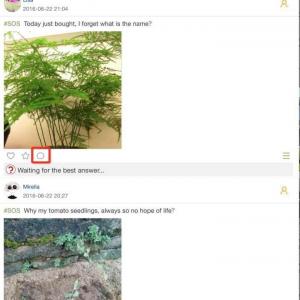
1How to post SOS;
2How to answer flower friends' SOS


3
0
Citibear23:Asparagus fern
DaviddelC
2016年06月22日

Pretty flowers.


3
0
Colorful:😍😍❤️love it!
DaviddelC:Yup.
sunnyzou:Amazing!love this kind of flower!😍😍😍
Joss:Hydrangea?
Andrea
2016年06月22日

Chinese rose is a shrub growing to 1–2 m tall. The leaves are pinnate, have 3-5 leaflets, each leaflet 2.5–6 cm long and 1–3 cm broad. In the wild species , the flowers have five pink to red petals. The fruit is a red hip 1–2 cm diameter.
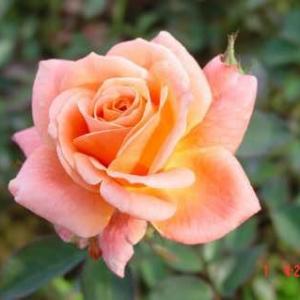
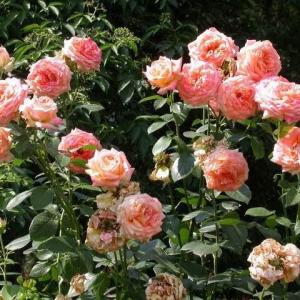


2
0
Selina
2016年06月22日

Walking iris plants (Neomarica spp.), also known as twelve apostles, are herbaceous perennials that grow to a height of 1 1/2 to 3 feet. They bloom off and on in spring, summer and fall, producing small, iris-type flowers.




0
0
求助
Andrea
2016年06月22日

#SOS whats kind of this flowers?


1
0
sunnyzou:中文名耧斗菜
sunnyzou:Aquilegia viridiflora Pall


